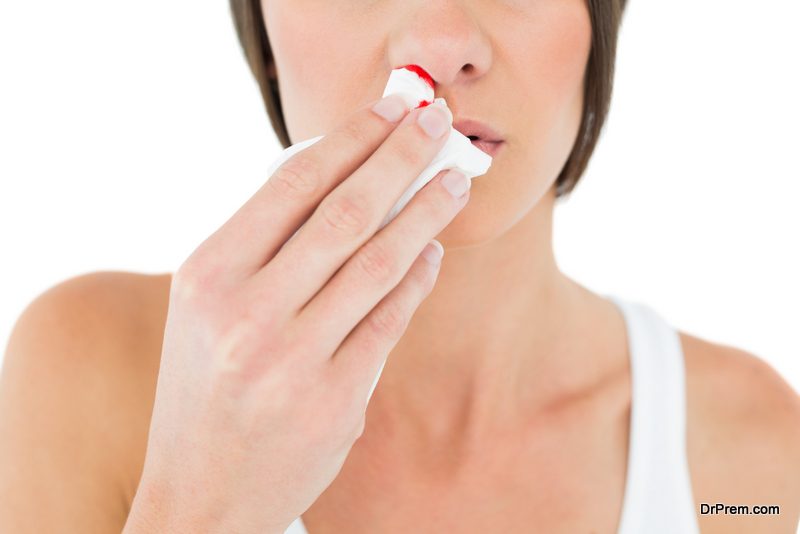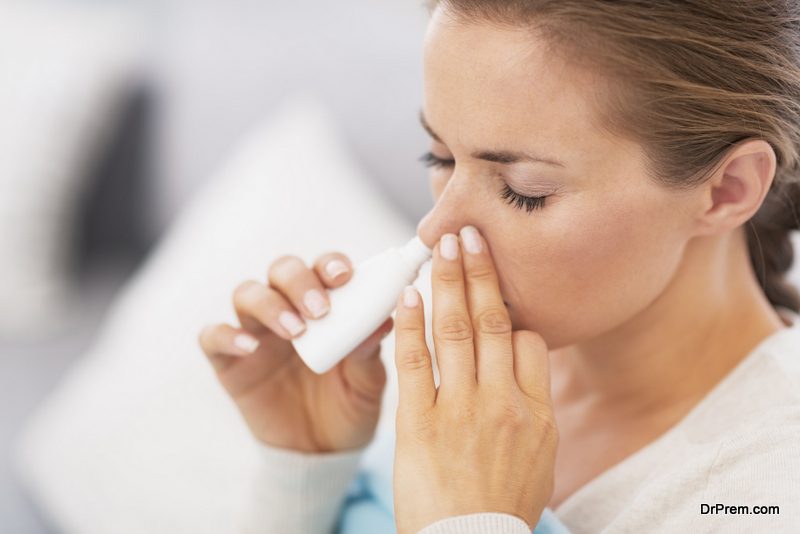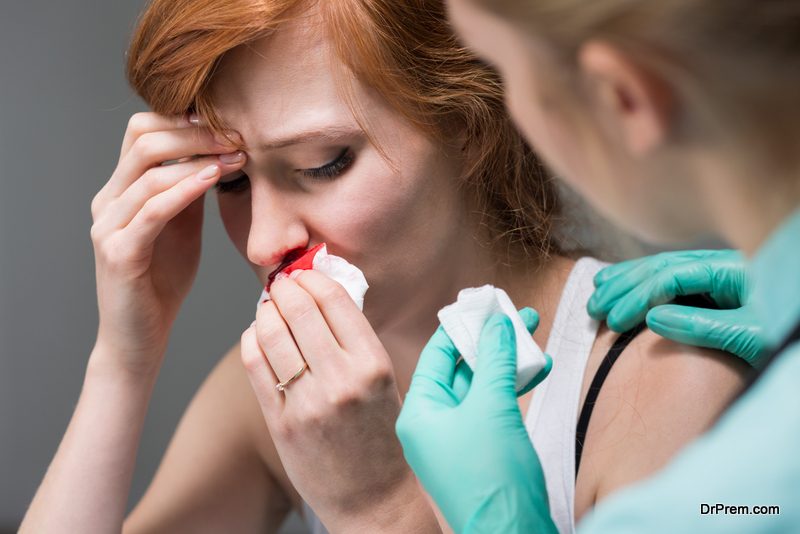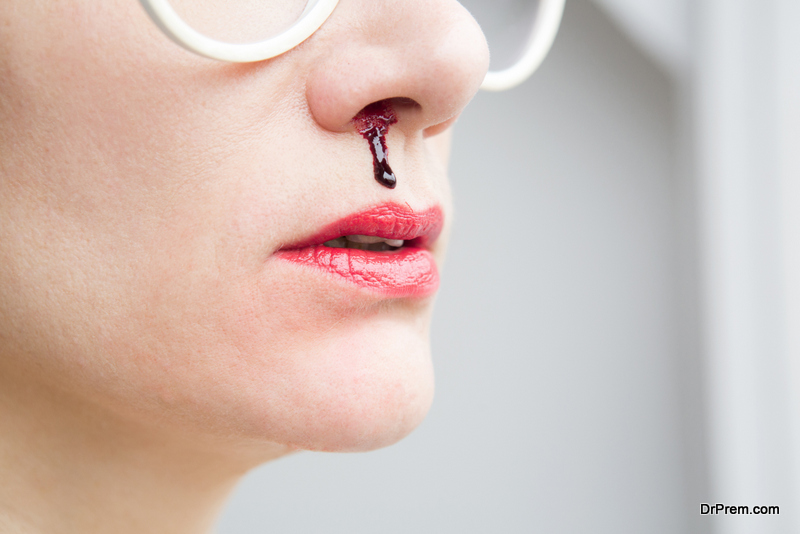Most nosebleeds are quite normal and only happen due to rupturing of the blood vessels within your nose. These blood vessels are quite tiny, to begin with, and are placed pretty close to the surface. This is why they are the first to burst open and bleed at the slightest of injuries. Nosebleeds may look ugly and messy, but there is seldom any reason to worry.
This phenomenon is quite common in kids who may hurt themselves while playing and in winters. Usually, only one nostril bleeds in such cases. Kids and people with high blood pressure are also at a larger risk of encountering frequent bleeding from the nose on long or red-eye flights.
It is pretty simple to prevent winter nosebleeds. Make sure you keep your nose well hydrated, apply coconut oil on the inside of your nose, and refrain from picking at the dry skin within as much as you can.
Why do nosebleeds occur?
 Frequent bleeding from the nose is quite common and unpredictable. However, some basic reasons why nosebleeds occur boil down to a few:
Frequent bleeding from the nose is quite common and unpredictable. However, some basic reasons why nosebleeds occur boil down to a few:
- Injury on the nose or face
- Sticking something up your nose
- Dried, humid weather
- Large temperature or pressure difference
- Allergy, cold, continuous sneezing
- Dry, cracked, itchy, and crusty nose
Winters are full of dry weather. Moreover, the dry and heated indoor air poses a large temperature difference as opposed to the indoors. An absence of regular moisturising of the nose during the winters is one of the major causes of nosebleeds. But to prevent winter nosebleeds and taking care of it is pretty simpler than most of us think.
How to prevent winter nosebleeds?
 Winter time sees plenty of bleeding noses, most of which are harmless. However, these can be scary enough for children and their parents. Here are some measures you can undertake in order to avoid these situations.
Winter time sees plenty of bleeding noses, most of which are harmless. However, these can be scary enough for children and their parents. Here are some measures you can undertake in order to avoid these situations.
- Keep the inside of your nose moist by using nasal sprays, coconut oil, petroleum jelly, or an antiseptic ointment.
- Make sure you use a humidifier in your homes, since winter usually leads to extreme air dryness.
- Avoid inserting things and fingers in your nose. This may rupture the blood vessels close to the surface leading to more bleeding.
- Refrain from smoking and use frequent medications for allergy often.
What should you do when a nosebleed occurs?
 If a nosebleed occurs, sit down in an open area for fresh air. No matter how difficult it may, sound, panicking never helps in such a situation. Most people tend to tilt their head back when a nosebleed occurs, which is never a good idea.
If a nosebleed occurs, sit down in an open area for fresh air. No matter how difficult it may, sound, panicking never helps in such a situation. Most people tend to tilt their head back when a nosebleed occurs, which is never a good idea.
- Tilt your head: Always tilt your head forward and allow the blood to flow. Looking up or lying down in this case will cause blood to run back up your nose blocking it, or you may end up inhaling some blood. This leads to nausea and diarrhoea, and swallowing blood is never good for the gut.
- Pinch your nose flesh: Pinch the nose flesh between your fingers to squeeze out as much blood possible. Make sure you press your nose against the face to stop bloody nose from dripping down. Continue doing this until your nose has ceased to bleed.
- Shut your nose: Press shut your nose using your fingers for at least 10 minutes straight. This should help by stopping the nosebleed. Breathe through your mouth during this period.
- Avoid Sneezing: In winters, a useful tip to prevent winter nosebleeds is to avoid too much sneezing and coughing. And refrain from scraping at the dry skin inside your nose.
- Look up: Avoid lying down or looking up as much as you can. Also, don’t bend forward too. Let your head remain elevated. You can sit down or rest, but don’t lie down.
- Apply Ice Pack: Once the bleeding has stopped, apply an ice pack to your nose and cheeks. This will aid in soothing the area preventing any more bleeding. Don’t forget to rinse your nose with plain water later on, but only as lightly as you can.
- Use Nasal Sprays: To treat and prevent winter nosebleeds, you can consider using nasal sprays like phenylephrine-DM-guaifenesin (Duravent) or Oxymetazoline (Afrin). However, use these only if your nosebleeds are an occasional occurrence to avoid harmful side effects like congestion. It may take 7-10 days for the blood vessels in your nose to heal completely.
If you want to stop bloody nose, allow the blood to clot within. This clot may go on to become a hindrance while breathing. Even so, no matter how tempting it may be, never pick at this clot until it is completely healed. Pulling it out may cause your nose to start bleeding all over again.
Another useful tactic to prevent winter nosebleeds is to adjust the temperature within your home. Although winters can get quite cold, ensure that the difference doesn’t become too large since that may take a toll on your health and result in a nosebleed.
When to worry and approach a doctor?
 Nosebleeds are quite a common occurrence. It’s time to go see a doctor if:
Nosebleeds are quite a common occurrence. It’s time to go see a doctor if:
- Your nose continues to bleed even after pressing it for 15-20 minutes
- You have a prior history of cardiovascular disorders, atherosclerosis, hypertension, diabetes, or any other chronic disease
- You have faced a head injury before and your nose bleeds from both nostrils
- You have a vitamin K deficiency, which may prohibit blood clotting
- You have thrombophilia, a genetic issue which doesn’t allow blood clotting
Summing it up:
Even when a nosebleed occurs under the most unprepared of circumstances, there is nothing to worry about. Also, it is very simple to prevent winter nosebleeds. It’s a common sight in the cold and dry winter weather, especially in kids. Sure, kids can be a little difficult to manage in such situations, try and calm them down. Distract them as much as you can.
Jumping and playing around with a nosebleed for a kid can be pretty harmful. Make sure you stack up on tissues within an arm’s reach if you or your family members are prone to frequent nosebleeds. Also, nasal sprays can work wonders in this regard.


